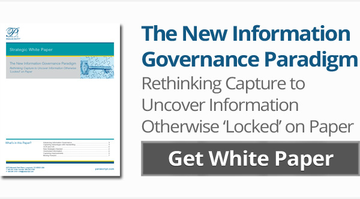Organizations today are looking for ways to shed light on “Dark Data” – information that organizations have available to collect, process and store during regular business activities, but that gets overlooked, lost, or is left unused in the process. It includes, among other things, handwritten data that exists on forms, contracts, and a variety of everyday business documents. This information often gets missed, but it can represent a treasure trove of opportunity for organizations looking to cash in on the value of overshadowed and overlooked handwritten content.
What did you miss?
Despite the increasing digitization of business today, a great number of business forms and documents still contain handwritten entries – replies, notes and signatures – that are vitally important, especially when you begin to look at this data from an information governance point of view. Legal discovery, privacy, compliance, process improvement, archival and retention, and a host of other aspects and applications all point to the importance of handwritten content. Here are three examples to consider:
#1 – Annotations – If you think handwritten annotations are no big deal, just ask any lawyer or legal counsel and they will tell you that and written information on documents like contracts or depositions are incredibly important. The presence of – or lack of – handwritten revisions, changes and initials can have both an immediate and long-term impact on the efficacy of a wide range of business critical processes and information.
#2 – Comments – A great deal of important information is contained in handwritten comments, yet most of this data is overlooked or lost in the capture process. Indeed, companies find valuable insight in comments like “this product is defective,” or “response was slow” that can be a powerful advantage to improve products, services and performance.
#3 – Signatures – The function and completion of many key business processes often comes down to a physical handwritten signature. Loan transactions, lease and rental contracts, and a variety of authorizations across many key functions all require a company to either confirm that a signature is present and/or match a signature for transaction enablement.
How do you know what you don’t know?
In any organization there is handwritten information that is never noticed, never leveraged, and no one ever thinks about. The question becomes: How do you know what you don’t know…and how it is hurting you? Organizations can no longer afford to ignore valuable handwritten content, especially as demands for improved information governance increase. Indeed, handwritten data and free-format fields play an important role in most business processes – and an increasing important one as organizations seek to exploit the Big Data they may contain.
Learn more:

